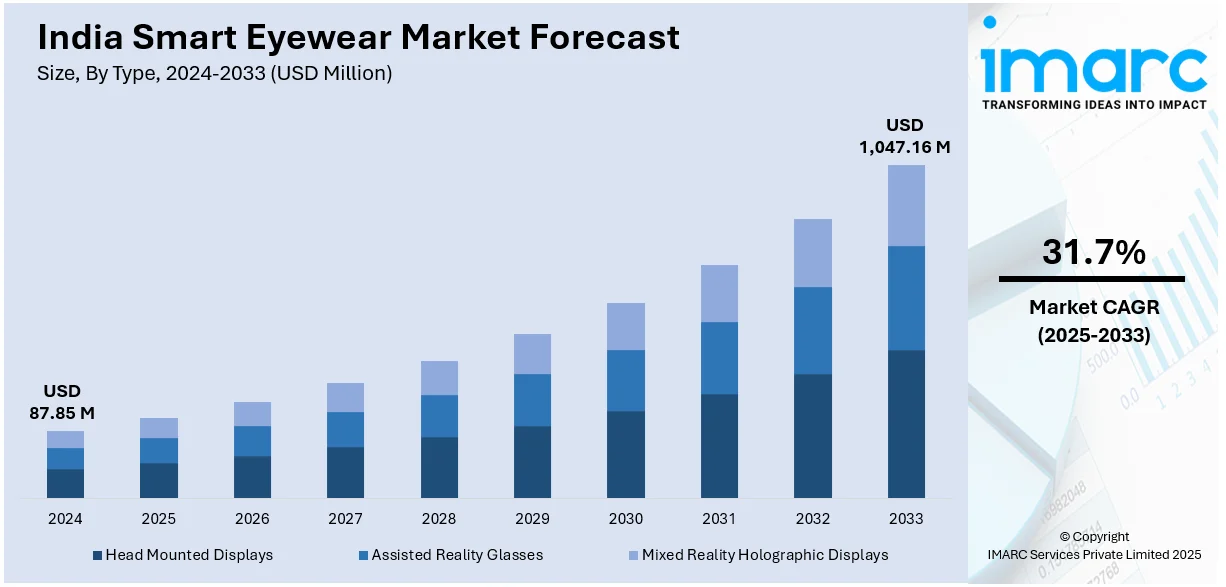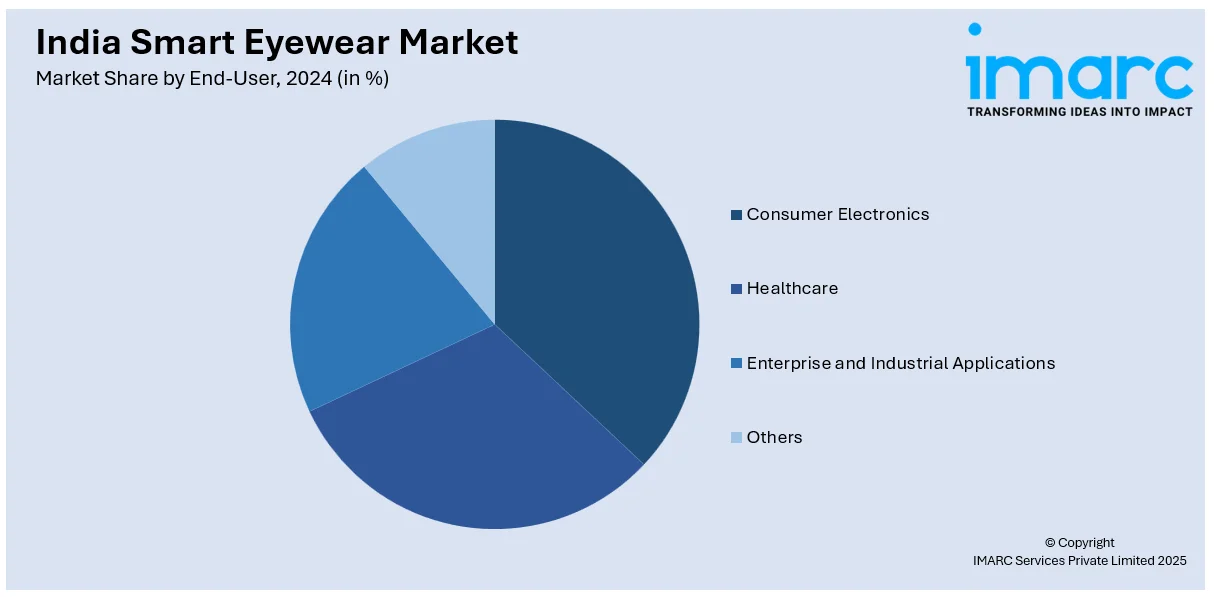
India Smart Eyewear Market Size, Share, Trends, and Forecast by Type, Technology, Operating System, End-User, and Region, 2025-2033
India Smart Eyewear Market Overview:
The India smart eyewear market size reached USD 87.85 Million in 2024. Looking forward, IMARC Group expects the market to reach USD 1,047.16 Million by 2033, exhibiting a growth rate (CAGR) of 31.7% during 2025-2033. The rising digital adoption, increasing consumer interest in augmented reality (AR) and virtual reality (VR), growing smartphone integration, advancements in AI-powered vision assistance, expanding fitness and health monitoring applications, and demand for hands-free connectivity in professional and personal use are the factors propelling the growth of the market.
|
Report Attribute
|
Key Statistics
|
|---|---|
|
Base Year
|
2024 |
|
Forecast Years
|
2025-2033
|
|
Historical Years
|
2019-2024
|
| Market Size in 2024 | USD 87.85 Million |
| Market Forecast in 2033 | USD 1,047.16 Million |
| Market Growth Rate 2025-2033 | 31.7% |
India Smart Eyewear Market Trends:
Customization and Multifunctionality in Smart Eyewear
The smart eyewear industry is growing, with a focus on personalization and functionality. Users may now personalize frames and lens settings, as well as advanced display and audio functions. Consumers are looking for wearables that combine technology and style, providing both convenience and an improved user experience. The trend toward modular and flexible architecture reflects the increasing desire for individualized digital interactions in everyday life. Smart glasses are evolving beyond merely visual assistance, with immersive audio experiences, hands-free connection, and interactive displays. As wearable technology improves, the demand for adaptive and user-centric designs propels the next generation of smart eyewear, making it a more integrated and practical element of modern living. For example, in February 2025, Focally introduced 'Spectunes' smart glasses in India, featuring swappable frames and 16.7 Million color lenses. These customizable glasses integrate audio and display technologies, allowing users to personalize both style and functionality. This launch signifies a significant advancement in India's smart eyewear market, offering consumers innovative and versatile wearable technology options.

To get more information on this market, Request Sample
Advancing AI-Powered Assistive Technology
Embedding artificial intelligence in assistive devices is revolutionizing accessibility technologies for the visually impaired. AI-driven smart glasses are re-emerging as a vital innovation, offering real-time reading support, object recognition, and face detection. These features boost autonomy, allowing users to navigate public spaces, recognize individuals, and access information better. With international organizations highlighting the prevalence of unavoidable visual impairments, the need for smart assistive devices is on the rise. Advances in wearable technology are reducing the complexity of the devices, making them lighter and more flexible for different settings. With further advancements in AI, assistive smart glasses are increasingly becoming more advanced, bridging the gap between visual impairment and independent mobility, eventually enhancing the quality of life for millions of people around the globe. According to the World Health Organization, approximately 22% of visual impairments are uncorrectable. SHG Technologies, a Bangalore-based company, launched 'SMART VISION Glasses' to assist India's visually impaired population. These AI-powered glasses offer reading assistance, object identification, and facial recognition, enhancing users' independence.
India Smart Eyewear Market Segmentation:
IMARC Group provides an analysis of the key trends in each segment of the market, along with forecasts at the region/country level for 2025-2033. Our report has categorized the market based on type, technology, operating system, end-user.
Type Insights:
- Head Mounted Displays
- Assisted Reality Glasses
- Mixed Reality Holographic Displays
The report has provided a detailed breakup and analysis of the market based on the type. This includes head mounted displays, assisted reality glasses, and mixed reality holographic displays.
Technology Insights:
- Augmented Reality
- Virtual Reality
A detailed breakup and analysis of the market based on the technology have also been provided in the report. This includes augmented reality and virtual reality.
Operating System Insights:
- Android
- Linux
- Others
The report has provided a detailed breakup and analysis of the market based on the operating system. This includes android, Linux, and others.
End-User Insights:

- Consumer Electronics
- Healthcare
- Enterprise and Industrial Applications
- Others
A detailed breakup and analysis of the market based on the end-user have also been provided in the report. This includes consumer electronics, healthcare, enterprise and industrial applications, and others.
Regional Insights:
- North India
- South India
- East India
- West India
The report has also provided a comprehensive analysis of all the major regional markets, which include North India, South India, East India, and West India.
Competitive Landscape:
The market research report has also provided a comprehensive analysis of the competitive landscape. Competitive analysis such as market structure, key player positioning, top winning strategies, competitive dashboard, and company evaluation quadrant has been covered in the report. Also, detailed profiles of all major companies have been provided.
India Smart Eyewear Market News:
- In March 2025, a team of electrical engineering students in India developed innovative smart glasses designed to assist visually impaired individuals. These glasses utilize ultrasonic sensors to detect obstacles within a 3.5-meter range, providing real-time audio feedback to users. This development represents a significant advancement in assistive technology, enhancing mobility and safety for the visually impaired community.
- In February 2025, Lenskart introduced its first smart eyewear, 'Phonic,' in India, priced at INR 4,000. The Phonic offers up to seven hours of battery life and is available for purchase on Lenskart's official website and offline stores.
India Smart Eyewear Market Report Coverage:
| Report Features | Details |
|---|---|
| Base Year of the Analysis | 2024 |
| Historical Period | 2019-2024 |
| Forecast Period | 2025-2033 |
| Units | Million USD |
| Scope of the Report | Exploration of Historical Trends and Market Outlook, Industry Catalysts and Challenges, Segment-Wise Historical and Future Market Assessment:
|
| Types Covered | Head Mounted Displays, Assisted Reality Glasses, Mixed Reality Holographic Displays |
| Technologies Covered | Augmented Reality, Virtual Reality |
| Operating Systems Covered | Android, Linux, Others |
| End-Users Covered | Consumer Electronics, Healthcare, Enterprise and Industrial Applications, Others |
| Regions Covered | North India, South India, East India, West India |
| Customization Scope | 10% Free Customization |
| Post-Sale Analyst Support | 10-12 Weeks |
| Delivery Format | PDF and Excel through Email (We can also provide the editable version of the report in PPT/Word format on special request) |
Key Questions Answered in This Report:
- How has the India smart eyewear market performed so far and how will it perform in the coming years?
- What is the breakup of the India smart eyewear market on the basis of type?
- What is the breakup of the India smart eyewear market on the basis of technology?
- What is the breakup of the India smart eyewear market on the basis of operating system?
- What is the breakup of the India smart eyewear market on the basis of end-user?
- What are the various stages in the value chain of the India smart eyewear market?
- What are the key driving factors and challenges in the India smart eyewear market?
- What is the structure of the India smart eyewear market and who are the key players?
- What is the degree of competition in the India smart eyewear market?
Key Benefits for Stakeholders:
- IMARC’s industry report offers a comprehensive quantitative analysis of various market segments, historical and current market trends, market forecasts, and dynamics of the India smart eyewear market from 2019-2033.
- The research report provides the latest information on the market drivers, challenges, and opportunities in the India smart eyewear market.
- Porter's five forces analysis assist stakeholders in assessing the impact of new entrants, competitive rivalry, supplier power, buyer power, and the threat of substitution. It helps stakeholders to analyze the level of competition within the India smart eyewear industry and its attractiveness.
- Competitive landscape allows stakeholders to understand their competitive environment and provides an insight into the current positions of key players in the market.
Need more help?
- Speak to our experienced analysts for insights on the current market scenarios.
- Include additional segments and countries to customize the report as per your requirement.
- Gain an unparalleled competitive advantage in your domain by understanding how to utilize the report and positively impacting your operations and revenue.
- For further assistance, please connect with our analysts.
 Request Customization
Request Customization
 Speak to an Analyst
Speak to an Analyst
 Request Brochure
Request Brochure
 Inquire Before Buying
Inquire Before Buying




.webp)




.webp)












